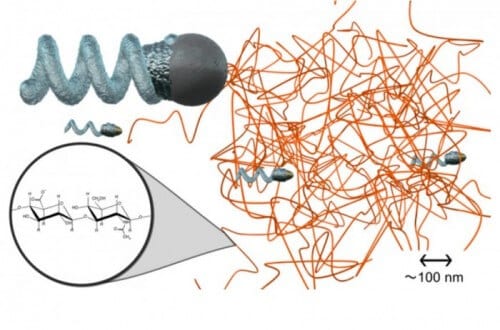Scientists have succeeded in producing robots that are only a few nanometers long, and are tiny enough to navigate inside the human body and possibly even inside human cells

[Translation by Dr. Nachmani Moshe]
If you thought that the most sensational news these days in the field of miniaturization technology are smart watches, then you are wrong. Scientists are quietly working in their laboratories to develop nanometer-sized robots, nanorobots that are tiny enough to navigate inside the human body and possibly even inside human cells. At the moment, one can only imagine what the impact of these wonderful microscopic machines will be on the field of medicine, but there is no doubt that it will be enormous. One of the first steps in developing these robots is the need to understand how to make them move. In an article published last June in the scientific journal ACS Nano, an international team of researchers from Israel and Germany announced that it had succeeded in producing a tiny screw-like propeller that is able to move within a clot-like liquid (gel) that mimics the environment inside a living being. The team consists of researchers from the Technion - Israel Institute of Technology, the Max Planck Institute and the Institute of Physical Chemistry at the University of Stuttgart, Germany.
The fiber that makes up the propeller, made of silica and nickel, is only 70 nanometers in diameter; The overall size of the propeller is 400 nanometers. "If you compare the diameter of the propellers to a human blood cell, the diameter of the propeller is a hundred times smaller," said one of the researchers who is the director of the Molecular Systems Laboratory at the Max Planck Institute. The propellers are so tiny that their motion is easily affected by the motion of nearby molecules (a phenomenon known as 'Brownian motion').
The team already knew that tiny propellers move properly in an aquatic environment, but in order to test whether they can move inside living creatures, they chose hyaluronan (hyaluronic acid, glycosaminoglycan), a substance found in abundance in the human body, including in the fluids of connective tissues, epithelial and nervous tissues. The hyaluronic clot includes a network of long proteins called polymers; The polymers are long enough to prevent micrometer-sized propellers from moving through them, but their openings are large enough for nanometer-sized objects to pass through easily. The scientists were able to control the movement of the tiny propellers with the help of a relatively weak rotating magnetic field.
The findings were quite surprising - the team expected that it would encounter problems controlling the movement of the nano-thrusters, since in light of their size they began to be controlled by a flutter, as if they were molecules. However, in light of the fact that the nanopropellers are the same size as the mesh inside the clot, they "actually exhibit significantly increased movement speeds, far above the highest speeds measured in comparison with the glycerin material for the micropropellers," notes the lead researcher.
Although the nanopropellers are spectacular in terms of their technical complexity, their practical importance lies in the possible impact they will have on the field of medicine. "Our nanoscale system can be used for target-oriented applications, for example, inside the eye where they can be driven to a precise location within the retina," says the lead researcher. Scientists will also be able to attach "active molecules" to the tip of the propellers or use them to move tiny radiation sources to specific locations in the body drum. It seems on the face of it that the possible applications are extensive, varied and fascinating.
